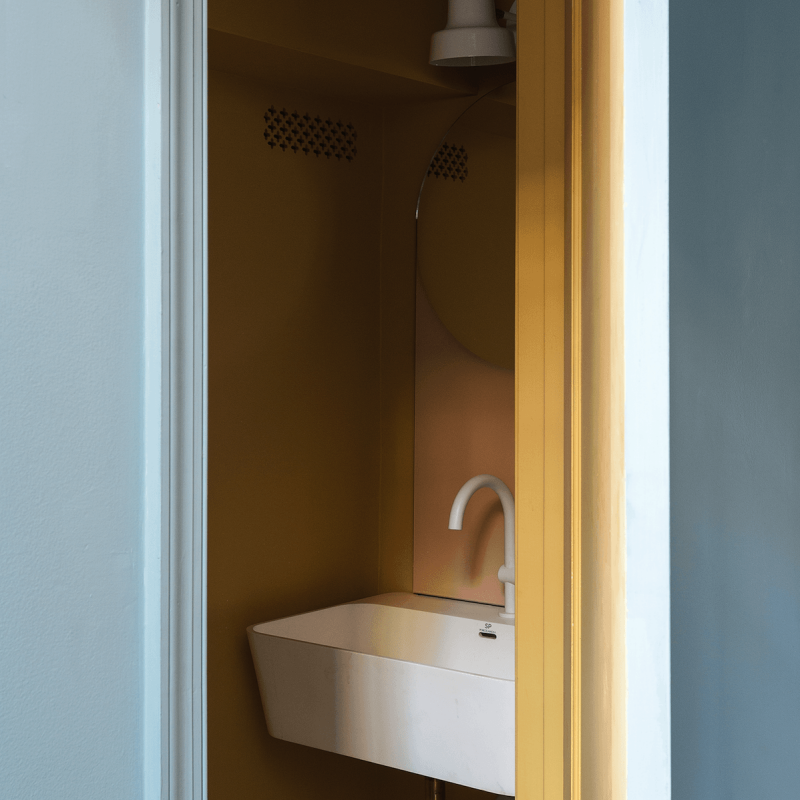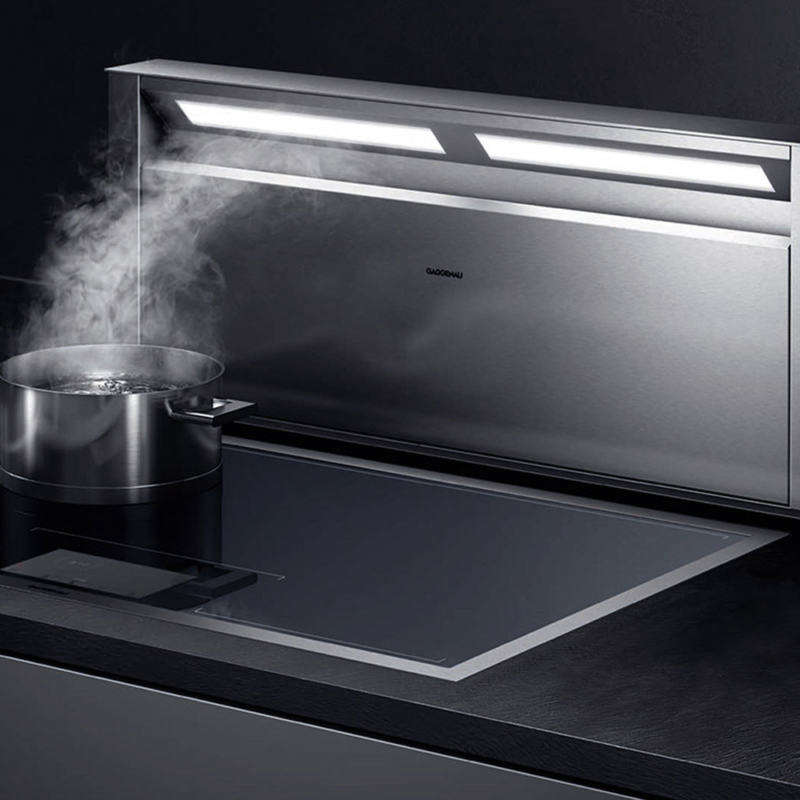The thing about cooking—especially frying and grilling—is that it can kick up a lot of smoke, grease, and lingering food smells. A range hood helps keep the air in your kitchen clean. These appliances come in several different models, some more effective than others. Here’s a quick guide to help you find the hood that’s right for your space.

What are the different types of range hoods?
1. Range Hoods
Range hoods come in several styles: Under-cabinet hoods are mounted on the bottom of a kitchen cabinet that’s directly over the stove. A wall chimney hood (or wall-mounted hood) is installed on the wall when there’s no cabinet over the stove. An island (or ceiling-mounted) hood is attached to the ceiling over a stove that sits on an island or peninsula. Most of these overhead hoods include lighting that illuminates your cooktop, and all of these styles can be found vented or unvented.
2. Downdraft Systems
Another type of range ventilation is the downdraft system, which sits beside or behind the stovetop and sucks air down to a duct that runs under the floor. These look great because they’re barely visible (they can even be retracted when not in use), but they don’t work as well as overhead hoods. (See Remodeling 101: Nearly Invisible Downdraft Kitchen Vents for more.)
3. Microwaves with Build-In Hoods
And lastly, while they’re not strictly range hoods, microwave ovens designed to be mounted over the range generally come with a hood, either vented or unvented, to recirculate air from the cooktop.

What’s the difference between a vented range hood and an unvented one?
Vented Range Hoods: The fan in a vented range hood is attached to a duct, so it moves air from the kitchen to the outdoors.
Unvented Range Hoods: An unvented, or ductless, range hood has a fan but no duct. Instead, it uses several types of filters to clean the air, and then recirculates the air into the kitchen (these models are sometimes called recirculating hoods).
Is a vented range hood better than an unvented one?
Without question. It’s far preferable to vent the air outdoors than to recirculate it into the room. A vented hood that removes steam, smoke, heat, and cooking odors is the best way to keep your kitchen clean, since it gets rid of grease particles that would otherwise accumulate on your walls and cabinets.
Unvented range hoods do filter some grease and cooking odors from the air, but the general consensus is that they’re nowhere near as effective. Nor do they remove heat and humidity, so they won’t help keep your kitchen cool while you cook.

Why would I ever want to install an unvented range hood?
Sometimes, installing a vented range hood isn’t possible because of the layout of the kitchen, especially if it’s in a condo or apartment. When a vented hood is mounted under the cabinet or on a wall, the duct has to run through or behind the cabinets to an outer wall. For a ceiling-mounted or island range hood, the duct must run above the ceiling.
If you don’t already have the duct in your kitchen, it can be expensive (or sometimes impossible) to install one. Also, the location of the duct dictates where your range will be placed in the room—a duct run that’s too long or twisty is less effective. (You may have to add a booster fan in these cases.)
A ductless range hood can be mounted anywhere, which saves money. It’s also more practical if you’re renting. And it uses less energy, since the fan doesn’t need to blow as hard.

What do I need to consider when I’m buying a range hood (unvented or vented)?
There are a number of factors to weigh, depending on the size and layout of your kitchen, and the type of cooking you do. Some things to consider:
- Size: The hood needs to cover the entire area of the range top to capture emissions from all the burners, so measure the size of your range before you start shopping.
- CFM: This refers to how powerful the fan is. It stands for cubic feet per minute, a measure of how long it takes for the air in the room to pass through the range hood. If you have a large kitchen and/or a professional range, you’ll need a more powerful fan.
- Noise level: There’s probably no such thing as a quiet range hood, but some are noisier than others, generally depending on how powerful the fan is. Check the specs and compare different models.
- Type of filters: If you’re sourcing an unvented hood, all models have replaceable charcoal filters to clean the air of odors and fumes. They also have multi-layered baffle or mesh filters that trap grease particles; these can often be cleaned in the dishwasher.
- Design: A range hood, especially an island hood that drops down from the ceiling, is a high-profile addition to your kitchen. A number of designers are making high-end European-style range hoods that look more like sculptures than appliances. Because a range hood is so visible, you’ll want to find one that fits your aesthetic.
You’ll also want to consider such features as adjustable fan speeds and lighting levels (usually halogen or LED), and perhaps automatic shutoff. As always, look for product reviews on consumer websites, and read user comments on the retail sites before you buy.

Is there a cost difference between vented and unvented range hoods?
Prices for range hoods vary anywhere from around $80 to more than $2,000, depending on the size, manufacturer, and design. Many range hoods on the market can be used vented or unvented, so you’ll pay the same except for the added filter or conversion kit.

What if I have no other choice but an unvented range hood?
To be sure, an unvented hood is better than no kitchen ventilation system at all. And depending on the type and amount of cooking you do, it might fit your needs just fine. If you don’t cook that much, ventilation shouldn’t be a big issue. If you only cook vegetarian food and never deep-fry, you won’t have a lot of grease and smelly odors to contend with. And if you like to clean, as some people apparently do, you won’t mind regularly swabbing down exposed surfaces to avoid that greasy buildup on your cabinets.
More ins and outs of range ventilation systems:
- Remodeling 101: Nearly Invisible Downdraft Kitchen Vents
- Remodeling 101: Ceiling-Mounted Recessed Kitchen Vents
- Rehab Diaries: Tales from the Hood
Finally, get more ideas on how to evaluate and choose a new kitchen hood or vent in our Remodeling 101 Guide: Kitchen Hoods & Vents.
Frequently asked questions
What is the difference between vented and non-vented range hoods?
Vented range hoods, also known as ducted range hoods, exhaust air to the outside of the building through a duct system. Non-vented range hoods, also known as ductless or recirculating range hoods, filter the air and release it back into the kitchen.
Which is better, vented or non-vented range hoods?
The choice between vented and non-vented range hoods depends on several factors. Vented range hoods are generally considered more effective in removing cooking odors, heat, and moisture from the kitchen. Non-vented range hoods are easier to install and suitable for kitchens where ductwork installation is challenging or not feasible.
Do vented range hoods require a duct to be installed?
Yes, vented range hoods require a duct system to be installed, which channels the exhaust air to the outside of the building. The ductwork should be properly installed and routed to an exterior wall or roof vent.
Can non-vented range hoods be installed without a duct system?
Yes, non-vented range hoods can be installed without a duct system. They use filters to trap grease, smoke, and odors, and then recirculate the filtered air back into the kitchen. However, they may not be as effective as vented hoods in removing cooking byproducts from the kitchen.
Are vented range hoods more expensive than non-vented range hoods?
Vented range hoods may be more expensive than non-vented range hoods due to the additional cost of ductwork installation. However, the overall cost can vary depending on the specific model, brand, and features of the range hood.
Do vented range hoods require regular maintenance?
Vented range hoods require regular maintenance, primarily in terms of cleaning the grease filters and occasionally inspecting and cleaning the ductwork. Proper maintenance ensures optimal performance and prevents the buildup of grease and debris.
What types of kitchens are best suited for vented range hoods?
Vented range hoods are best suited for kitchens where it is feasible to install a duct system to vent the exhaust air outside. They are particularly effective in kitchens with heavy cooking, frequent frying, or high heat output appliances.
What types of kitchens are best suited for non-vented range hoods?
Non-vented range hoods are suitable for kitchens where installing ductwork is challenging or not possible. They work well in apartments, condominiums, or situations where ventilation options are limited.
Can non-vented range hoods be converted to vented range hoods?
In some cases, non-vented range hoods can be converted to vented range hoods by installing a duct system. However, this conversion may require modifications to the range hood and the kitchen structure, and it's best to consult with professionals to determine feasibility.
Can I use a ducted range hood as a non-vented range hood?
It is not recommended to use a ducted range hood as a non-vented range hood. Ducted range hoods are specifically designed to expel air through a duct system, and using them without proper ventilation can lead to inadequate performance and potential damage to the range hood.




Have a Question or Comment About This Post?
Join the conversation